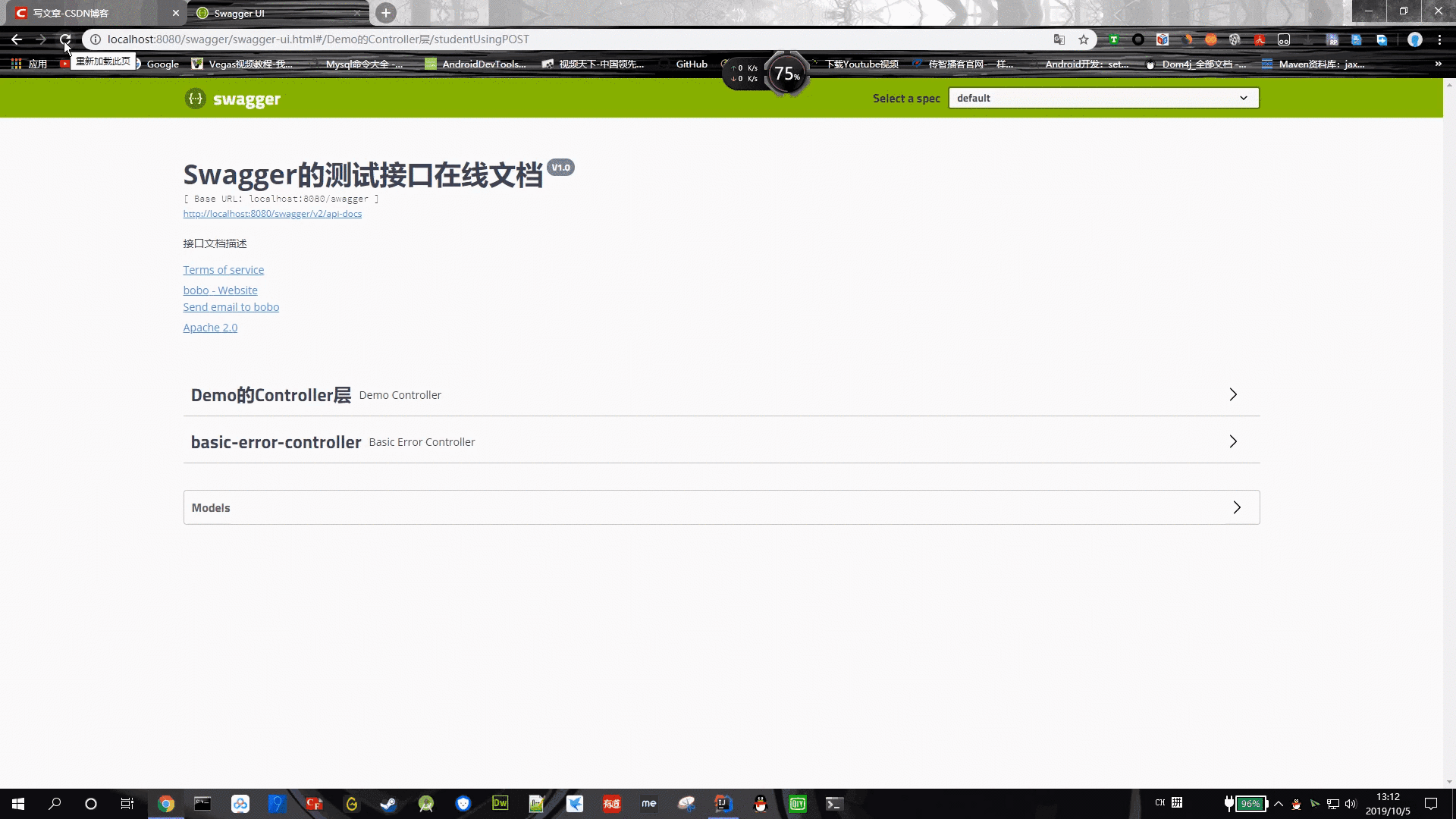什么是Swagger
Swagger使用于前后端分离开发的一款框架,能够动态的显示接口的信息并且对接口进行调试。优点为使用方便,配置简单,减少工作量等。访问路径(项目完整路径 + swagger-ui.html)注:Swagger推荐使用Restful接口开发规范
Swagger官网
DemoGithub
Swagger的配置
Swagger依赖
<!-- https://mvnrepository.com/artifact/io.springfox/springfox-swagger2 -->
<dependency>
<groupId>io.springfox</groupId>
<artifactId>springfox-swagger2</artifactId>
<version>2.9.2</version>
</dependency>
<!-- https://mvnrepository.com/artifact/io.springfox/springfox-swagger-ui -->
<dependency>
<groupId>io.springfox</groupId>
<artifactId>springfox-swagger-ui</artifactId>
<version>2.9.2</version>
</dependency>
配置
package com.tqb.swagger.config;
import org.springframework.context.annotation.Bean;
import org.springframework.context.annotation.Configuration;
import org.springframework.core.env.Environment;
import org.springframework.core.env.Profiles;
import org.springframework.web.bind.annotation.RestController;
import springfox.documentation.builders.RequestHandlerSelectors;
import springfox.documentation.service.ApiInfo;
import springfox.documentation.service.Contact;
import springfox.documentation.spi.DocumentationType;
import springfox.documentation.spring.web.plugins.Docket;
import springfox.documentation.swagger2.annotations.EnableSwagger2;
import java.util.ArrayList;
/**
* @ClassName SwaggerConfig
* @Description: TODO
* @Author 田清波
* @Mail tqb820965236@163.com
* @Date 2019/10/3 15:40
* @Version v1.0
*/
@Configuration
@EnableSwagger2
public class SwaggerConfig {
/**
*
* @param environment 验证当前项目处于的环境(如生产 开发 测试等)
* @return
*/
@Bean
public Docket docket(Environment environment){
/**
* 可用swagger的环境
*/
Profiles of = Profiles.of("dev", "test");
boolean flag = environment.acceptsProfiles(of);
Docket docket = new Docket(DocumentationType.SWAGGER_2);
docket.apiInfo(apiInfo())
/**
* 设置swagger是否可用 主要用于不同环境
*/
.enable(flag)
.select()
/**
* 只扫描具有RestController注解的类
*/
.apis(RequestHandlerSelectors.withClassAnnotation(RestController.class))
/**
* 过滤器
*/
// .paths()
.build();
return docket;
}
/**
* 接口文档基本信息
* @return
*/
private ApiInfo apiInfo() {
return new ApiInfo(
"Swagger的测试接口在线文档",
"接口文档描述",
"V1.0",
"urn:tos",
contact(),
"Apache 2.0",
"http://www.apache.org/licenses/LICENSE-2.0",
new ArrayList()
);
}
/**
* 接口文档编写作者
* @return
*/
private Contact contact(){
return new Contact("bobo", "https://blog.csdn.net/weixin_42061805", "tqb820965236@163.com");
}
}
使用
注解
- @Api:主要用于接口描述(Controller)

- @ApiOperation : 接口具体方法的描述

- @ApiModel : 实体类的描述
- @ApiModelProperty : 实体类中属性的描述

- @ApiParam : 具体方法中参数的描述
代码
- 实体类
package com.tqb.swagger.pojo;
import io.swagger.annotations.ApiModel;
import io.swagger.annotations.ApiModelProperty;
/**
* @ClassName Student
* @Description: TODO
* @Author 田清波
* @Mail tqb820965236@163.com
* @Date 2019/10/5 12:51
* @Version v1.0
*/
@ApiModel("学生实体类")
public class Student {
@ApiModelProperty(value = "姓名", required = true)
private String name;
@ApiModelProperty(value = "性别", required = true)
private String sex;
@ApiModelProperty(value = "地址", required = true)
private String address;
public String getName() {
return name;
}
public void setName(String name) {
this.name = name;
}
public String getSex() {
return sex;
}
public void setSex(String sex) {
this.sex = sex;
}
public String getAddress() {
return address;
}
public void setAddress(String address) {
this.address = address;
}
}
- Controller
package com.tqb.swagger.controller;
import com.tqb.swagger.pojo.Student;
import io.swagger.annotations.Api;
import io.swagger.annotations.ApiOperation;
import org.springframework.web.bind.annotation.GetMapping;
import org.springframework.web.bind.annotation.PostMapping;
import org.springframework.web.bind.annotation.RequestBody;
import org.springframework.web.bind.annotation.RestController;
/**
* @ClassName DemoController
* @Description: TODO
* @Author 田清波
* @Mail tqb820965236@163.com
* @Date 2019/10/3 14:47
* @Version v1.0
*/
@RestController
@Api(tags = "Demo的Controller层", value = "/Demo")
public class DemoController {
@GetMapping("hello")
@ApiOperation(value = "hello接口", notes = "田青菠 2019-10-5", httpMethod = "GET")
public String hello(){
return "hello";
}
@PostMapping("student")
@ApiOperation(value = "添加学生", notes = "田青菠 2019-10-5", httpMethod = "POST")
public Student student(@RequestBody Student student){
return student;
}
}
其它
使用Restful开发中常用的注解
- @RequestBody : 请求参数中的实体类
- @PathVariable(value = “id”,required = true) : 请求路径中携带的参数
- @GetMapping : 请求方法
启动页面






 本文详细介绍了Swagger框架,一种用于前后端分离开发的工具,能够动态展示API接口信息并提供调试功能。文章涵盖了Swagger的配置、依赖引入及使用示例,包括实体类和控制器的注解说明。
本文详细介绍了Swagger框架,一种用于前后端分离开发的工具,能够动态展示API接口信息并提供调试功能。文章涵盖了Swagger的配置、依赖引入及使用示例,包括实体类和控制器的注解说明。
















 7564
7564

 被折叠的 条评论
为什么被折叠?
被折叠的 条评论
为什么被折叠?








